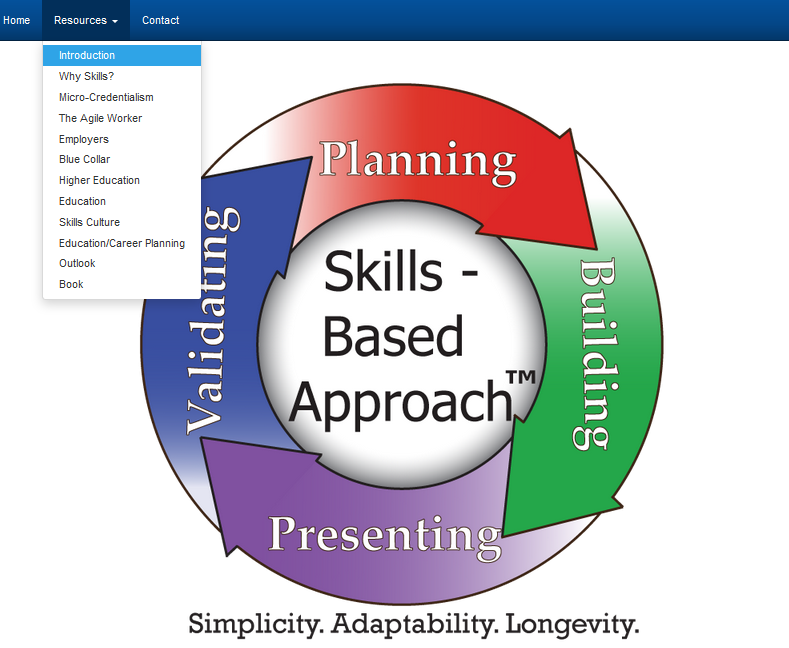I am going to share statistics and observations to illuminate the ‘Skills Gap’ problem, then present why I think a Skills Culture is the mindset and Skills Based Approach the methodology / application to tackle this and other problems related to lifelong learning.
Education
In standard education, US students are behind in basic skills. U.S. lags on both tails of basics skills measurement – higher rate for low basic skills and lower rate for high basic skills. For example, on the low end, ‘one in three adults have weak numeracy skills’ in this U.S. compared to ‘one in five’ for the cross country average. And, on the high end, ‘8 percent of adults scored the highest level’ in the U.S. compared to a ’13 percent cross-country’ average. – The Organization for Economic Co-Operation and Development (OECD): “Time for the U.S. to Reskill?”
There are improvements in Common Core; there will be more improvements. Only 18% of teachers strongly agree that their resources were aligned with the standards (up from 9% in 2002). – thirty-nine percent of teachers feel “very prepared” to teach the standards (up 20 percentage points from 2002). -EdWeek article
Students in high school are not engaged. Almost ‘three quarters of all surveyed fifth-grade students’ are engaged, while only ‘one-third of surveyed students in 10th, 11th and 12th grades are engaged”. - Gallup Survey
Skills Based Approach is effective in track learning in skill in education; Common Core is largely skills based. Skills Label is a resource to communicate and display what is being learned for any task. Skills Culture might be a way to improve poor engagement in high schools as students play a more active role and apply what they are learning.
Alternatives to Higher Education
The ‘other Skills Gap’ is about filling jobs not requiring a four-year degree. Over the next couple of years, there will be a resurgence of ‘the new blue collar’ with over 2.5 million good-paying jobs being added to the economy (representing nearly 40% of all job growth). - USA News article
Skills Based Approach is useful for tracking learning in all these new age programs for learning – bootcamps, microcredentials/nanodegrees, and traditional and emerging apprenticeships.
Higher Education
Employers are looking for applied skill when hiring. 84% ‘knowledge’ and 79% ‘applied skill’ are ‘very important’ in hiring decisions (compared to only 28% for ‘degree’ and 9% for ‘college attended’) - Gallup Poll.
Employers say students do not have required skills. 33% disagree and 34% are neutral to the statement higher education graduates have the skills my ‘business needs’ – Gallup Poll
Critical thinking is perhaps the single most important skill across disciplines and subjects.In his book Underachieving Colleges, Derek Bok says: “It is impressive to find faculty members agreeing almost unanimously that teaching students to think critically is the principal aim of undergraduate education.”
Higher education institutions are not doing an adequate job getting students to improve critical thinking. No statistically significant gain in critical thinking, complex reasoning, or writing skills for at least 45 percent of students. – Academically Adrift
I refer to this disconnect: Squeeze on Higher Education . Skills Based Approach suggests working with skills and competencies in higher education (applied learning), and tracking all the learning that takes place in and out of the classroom. For skills like Critical Thinking, we need to get a level deeper and understand the imparting of underlying methods and applications.
Professional
Employees lack the skills needed to do their job. In a survey of senior talent and strategy executives around the work, the most important future workplace strategy of its respondents (65%) is to ‘invest in reskilling current employers’. - Future of Jobs Survey conducted by World Economic Forum
Workers existing skill sets are expiring faster.
From the perspective of the executives. The top two technologic drivers already impacting employees’ skills. “mobile internet, cloud technology” (22%), “processing power, Big data” (13%) . - Future of Jobs
From the perspective of the workers. Fifty-four percent and thirty-three percent of workers say training / skills development throughout their work will be “essential “and “important, but not essential”. - Pew Research The State of American Jobs
Employers have a captive audience and incentive to train employees. “Sixty-three percent of low-skilled adults in the U.S. are employed” and “an intervention should yield lifetime returns”.- Future of Jobs
Occupation or specialties are changing too fast, require thinking in skills. “The most in-demand occupations or specialties did not exist 10 or even five years ago, and the pace of change is set to accelerate.” The Future of Jobs
Workers are required to makes sure they are adequately prepared with skills. Seventy-two percent of American adult workers say “a lot” of responsibility falls on individuals to make sure that they have the right skills and education. - Pew Research
Skills Based Approach suggests working with an evolving skill set, so students and professional constantly hone a skill set and remain relevant. It also suggests putting workers in the ‘driver seat’ of their learning. Finally, it is a platform for management and workers to negotiate training, demonstrated competencies, and plan future growth (onboarding and performance reviews).
